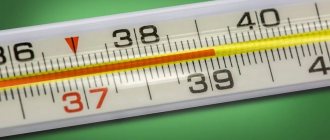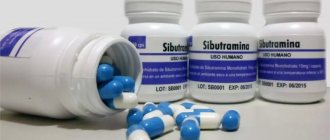Body temperature is an indicator of the internal environment of the body. Constancy of temperature is one of the main conditions for normal human life.
The body spends energy on digestion, brain activity, heart beats, muscle contraction and other physiological processes. This energy turns into heat, which is released by the body. The physiological mechanism responsible for body temperature is thermoregulation. Heat balance is controlled by a small region in the brain called the hypothalamus. It monitors the body’s energy expenditure: it can increase or decrease heat transfer.
Normal body temperature ranges from 36.5 to 37.5 0C in different parts of the body. During the day, the temperature can fluctuate: at 4–6 am it drops to 35.5–36 0С, in the evening it can rise to 37 0С. This is a daily rhythm, which is caused by different hormonal activity in the evening and morning.
Body temperature is measured in the anus, mouth and armpit. The last option is the most common: when it comes to body temperature, we usually mean measuring the temperature in the armpit. There the average is 36.6 0C.
Stable normal temperature of internal organs and blood maintains the constancy of biochemical reactions, the movement of electrolytes, the viscosity of intracellular fluid and the transport of biological fluids. Temperature also affects the processes of excitation and inhibition in the nervous system, protective reactions of the immune system, the release of hormones and the absorption of nutrients in the digestive tract.
In diseases and pathological conditions, body temperature increases (fever or hyperthermia) or decreases (hypothermia). Based on the dynamics and daily temperature fluctuations, one can suspect the type of infection, the stage of the disease and the degree of its severity.
What is the maximum body temperature recorded in humans?
This story took place in Atlanta (USA). The highest human temperature in the world was recorded there. American Willie Jones was admitted to a local hospital with heatstroke. The man's temperature rose to 46.7°C.
The event is marked with the date July 10, 1980. The man's condition was assessed as hyperfeverish and critically dangerous, but after just a few weeks of hospitalization he successfully recovered and went home. What prompted the heat for such a record? As we have already noted, we were talking about heat stroke. The paradox is that the air temperature that day barely exceeded 32°C with a humidity of 44%. For residents of Atlanta, this situation can be called quite familiar. For people around the world living in hot countries, this is a ridiculous temperature. For example, in Thailand the mark often exceeds 35°C with a humidity of 90%. Perhaps Willie Jones was engaged in intense physical activity on the street, which is why he was injured.
What does the human body temperature depend on?
It is no coincidence that the temperature of 36.6°C is set as normal. Back in the 19th century, the German physician Karl Wunderlich measured the indicator in the armpit area of 25 thousand patients about a million times. This is how the average value was derived, a deviation from which up or down is still a deviation from the norm. And yet, modern standards make amendments, allowing that the human body temperature can vary in the range from 36°C to 37.4°C.
It is now known that various factors, including age, can influence this indicator. For example, a temperature above 36.6°C in a child is quite normal. For older people, temperatures may reach lower values. High fever in children can be caused by a number of factors. For example:
- warm clothes;
- nervous overexcitation;
- eating;
- swimming in warm water.
That is why, if the child has not reached 1 year, the temperature should be closely monitored. After awakening, these indicators become noticeably lower. If the child begins to play actively, the temperature will rise.
Classification
According to the etiological factor, fever can be infectious - caused by bacteria, viruses and fungi, or non-infectious - with damage to internal organs, tumors, allergic reactions. Based on duration, high body temperature is classified into ephemeral (up to 3 days), acute (from 3 days to 2 weeks), subacute (2-6 weeks) and chronic (lasting over 1.5 months). In clinical practice, the classification of fever is more often used, taking into account the level of pathologically elevated temperature, according to which there is:
- Low-grade body temperature
. Temperature values are in the range of 37-38 degrees, accompanied by weakness, fatigue, and decreased ability to work. Often occurs in chronic, sluggish inflammatory processes in the body - some infections with a latent period, endocrine diseases. - Febrile body temperature
. Numerical indicators from 38° to 39° C. Its appearance indicates an active inflammatory process that triggers internal causes of fever: mechanisms of the immune system, massive production of endogenous pyrogens. It is observed in many infectious and somatic pathologies. - High (pyretic) body temperature
. Severe disturbance of thermoregulation with fever of 39-41° C. There is a sharp deterioration in condition, severe dehydration, attacks of nausea and vomiting. It is a pediatric emergency because children sometimes develop seizures. - Hyperpyretic body temperature
. An extremely serious condition when the temperature exceeds 41 degrees. Indicates a complete breakdown of the mechanisms of central thermoregulation. In addition to the usual symptoms of fever, disturbances of consciousness with delusions and hallucinations occur. The condition requires emergency assistance.
Doctors assess fever by how it fluctuates throughout the day—called a temperature curve. A constant temperature is characterized by fluctuations within 1 degree; with a weakening fever, the indicators change by 1-2 ° C, but do not reach normal temperature. With the hectic form, which is caused by purulent and septic processes, temperature fluctuations are 3-5 ° C during the day. More rare types of temperature curve include intermittent, recurrent and wavy.
Does the temperature indicator depend on the environment?
There are many places in the world where the body can be very hot or, conversely, very cold. Do not forget about zones of sharply continental climate. Acclimatization is often the biggest challenge for athletes. In high mountains, temperature values can change dramatically, creating a heavy burden on the human body.
Our body is warm-blooded and can maintain its temperature regardless of environmental conditions. However, the Willie Jones case showed that heatstroke can cause great harm. The human body itself cannot withstand strong temperature loads, so changes of literally 2° already have a negative effect on the body. Confusion, dizziness, malaise and other symptoms appear.
Often, when this value increases, people remember diseases. Indeed, activation of the immune system leads to a flux of chemical reactions, which causes high fever. This is how our body creates “uncomfortable” conditions for the pathogen in order to destroy it.
What types of temperature indicators are divided into?
It must be noted that not every temperature is high. In medicine, there are clear boundaries indicating a condition. The lowest limit starts from 37°C to 38°C. It is usually called low-grade fever. Febrile starts from 38°C to 39°C. A temperature exceeding 39°C is considered high. The most dangerous value starts from 40°C.
It is the boundaries that doctors operate when making a diagnosis. Note that these indicators are not the most important in determining the state. Other symptoms play a big role. A high temperature does not at all indicate a dangerous disease - there are many examples in the world when people found themselves in a state of fever, but there was no serious threat to their lives.
A constant temperature reading above 37°C and below 37.5°C may indicate the occurrence of processes associated with serious diseases.
Can the temperature fluctuate?
As we have already noted, temperature fluctuation is a natural process and depends on age. Fluctuations occur especially often when a person reaches adolescence up to 18 years of age. Various factors can influence fluctuations; physical activity always has a big influence.
It is important to know that high temperature readings may not be associated with diet, heavy physical activity or inflammation. There are many cases recorded around the world where a person who spends a long time in a stuffy room or in the heat is unable to lead normal life activities. This is due to the fact that his body has received a large temperature load and cannot restore normal heat transfer. This is how heatstroke begins. The consequences of this condition have the most detrimental effect on the brain.
Temperature that does not need to be reduced
The fever itself is not dangerous, and if the body temperature does not exceed 38.50 C, you can not bring it down1. Another question is that this worsens overall well-being. Along with the temperature (and sometimes regardless of it), a feeling of weakness, weakness, unmotivated fatigue, drowsiness, headache and muscle aches appear3. The picture is complemented by the symptoms of ARVI: runny nose, nasal congestion, sneezing, sore and sore throat, cough and other signs of respiratory tract damage. The main emphasis should be on combating these manifestations of the disease. Complex medications, such as TheraFlu for colds and flu, help reduce the severity of symptoms4. Thanks to the combination of several active components, TheraFlu fights headaches, body aches, nasal congestion, sneezing and other manifestations of ARVI5, regardless of whether the body temperature is elevated4.
What devices measure temperature indicators?
There is a wide variety of instruments in the world for measuring human body temperature. Thermometers still remain one of the most popular products, so global manufacturers offer a variety of models. The most famous type of thermometers in Russia are mercury thermometers. This thermometer is characterized by high accuracy, availability and is still in great demand. However, there are not as many such thermometers in the world as before, because they are quite fragile and pose a danger. The mercury they contain is poisonous. Its high degree of deodorization is dangerous and can cause harm to humans and animals.
Electronic thermometers have become more popular in the world. Their most interesting feature was the ability to measure indicators in just 30 seconds. As soon as the measurements are completed, the device will notify you with a sound signal. Alas, such devices do not provide accurate values. Therefore, manufacturers of such thermometers indicate the error in the instructions. Nevertheless, they are the ones who have gained the greatest popularity all over the world.
The most modern type of thermometers in the world are infrared. With their help, you can measure the indicator contactlessly, getting results in just 5 seconds. The error of this type of thermometer is very low and is no more than 0.5°C. A characteristic feature of the infrared thermometer is its limited use. It can only read data from a certain area, for example, the temple, forehead or ear. Moreover, the coverage is purely single, so if the device is designed to measure across the forehead, then it will be impossible to measure in another zone.
Nowadays thermal strips are becoming widespread around the world. They are widely used due to their ease of use. This strip can be applied to the forehead and in a minute it will show the result. The definition occurs along the boundaries, which helps to find out the most necessary information. Because of this, thermal strips cannot replace a full-fledged thermometer.
When is urgent medical attention needed?
- The thermometer shows 35°C, and the temperature continues to fall.
- A decrease in temperature is accompanied by bleeding, vomiting, speech and vision disturbances, loss of consciousness, hallucinations, severe yellowing of the skin and whites of the eyes.
- The temperature is reduced in a child or an elderly person and is combined with general poor health.
- There are signs of hypothermia: pale skin, bluish nasolabial triangle, chills, shortness of breath, rapid pulse, lethargy.
- Low temperature is especially dangerous for elderly and seriously ill people.
What are the different forms of fever?
The familiar pink (red) fever is not always a dangerous signal. She announces herself by redness of the skin, a characteristic blush on the cheeks. With red fever, the body is able to function quite normally and provide proper heat transfer.
The most serious danger is caused by white fever, which is recorded relatively rarely. It may be caused by vasospasm. With white fever, processes associated with thermoregulation fail. The skin becomes white, the hands become cold, and the thermometer shows a high temperature level. White fever is very dangerous because the heat can damage internal organs.
What consequences can high temperature cause?
There are 3 symptoms that make themselves felt when you have a high fever. These are nausea, pressure and diarrhea. The second should be focused on separately. Fever affects hemodynamics, leading to increased heart rate. Acceleration of blood flow leads to dilation of blood vessels and increased blood pressure. In this case, the indicators, as a rule, do not exceed 140/90 mm Hg. Increased blood pressure is typical for people who have a fever of 38.5°C. Sometimes the pressure may, on the contrary, decrease. You should not take medications that affect blood pressure, as the levels will level off on their own after the fever goes away.
Anyone who suffers from hypertension should be seriously wary, since even a slight increase in temperature can lead to big problems. Those suffering from hypertension need to take antipyretics. Anyone who suffers from arrhythmia, atherosclerosis, diabetes mellitus, or heart failure should also exercise caution. If low pressure is recorded at a high temperature (especially in the low-grade range), then pathology may occur. There is no need to be scared in advance, you just need to undergo a full examination.
Can a fever occur without other symptoms? If you experience an increase in temperature, but there are no other symptoms, you should immediately go for a medical examination. However, a similar condition can occur with nervous disorders, overwork, constant stress, hypothermia and heavy physical exertion. If the increase in temperature is temporary, there is no need to worry; if the condition persists, it is recommended to consult a specialist.
What can you do before seeing a doctor?
Raising your body temperature must be done very carefully. A sudden change in thermal conditions can lead to serious consequences.
- If the cause of low body temperature is hypothermia, place the frozen person in a warm room, change him into dry clothes, cover him with a blanket and give him warm sweet tea.
- Hot baths, tea, and intense rubbing of body parts can be harmful. Drinking strong alcoholic drinks is also highly undesirable.
- A small child should be fed, given a warm drink, hugged and warmed with your own warmth.
- If you're just overtired, take a break from what you're doing. Take two or three days off: get enough sleep, take a bath, walk in the fresh air. After such a complete rest, normal body temperature will be restored naturally.








